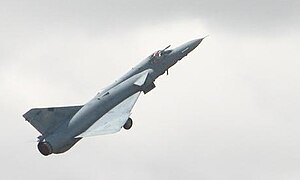South Africans With Surface to Air Missiles

"South Africa wants two, that's right —Tom Lehrer on South Africa's nuclear ambitions, from the song Who's Next?.
|
South Africa's military is an interesting one, primarily because of The Apartheid Era and their contribution to other wars.
Subject to a large-scale arms embargo, the South African regime was forced to develop its own weaponry, such as the Vektor R4 rifle and the Cheetah (modified Mirages). Many of their products were actually world-class or better - South African artillery, for instance, was widely regarded as the best in its class for several years. Also, it produced the Casspir and Buffel Infantry Fighting Vehicles (which are proof against landmines and Improvized Explosive Devices); the latter has a variant produced in the US as the Buffalo, and is a major inspiration behind the program to replace the Humvee (which is ridiculously vulnerable to landmines).
South Africans fought for Britain during World War Two and their Air Force turned up in Korea (earning a US Presidential Unit Citation).
During The Apartheid Era, the South Africans fought a border war with Angola (and unsuccessfully tried to stop Namibia, ex-German South West Africa, from gaining independence) against Marxist guerrillas- a reason why the US and UK were reluctant to challenge the regime too closely. Their main allies in Angola were the pro-West (but anti-colonialist) independence group UNITA. Their enemies were the Communist-backed MPLA, as well as forces from Cuba and the Soviet Union. While in Angola, the South Africans did quite well, but they eventually withdrew when reinforcements were needed for homeland defense.
Also during The Apartheid Era, South Africa was a nuclear state. The rationale was, while it was nominally allied to the West in the Cold War, it had Soviet-leaning neighbors who had no complicated embargo issues hindering their military development. Also, South Africa has a great deal of uranium. Also - in a strictly unofficial capacity - South Africa and Israel, the wild children of the non-communist world, entered into a technical-expertise-for-uranium trade relationship. And finally also, at the end of the 80s South Africa magnanimously destroyed their entire six-nuke arsenal and signed the nuclear non-proliferation treaty. The fact that the Apartheid administration was going to have to give way to the black majority in the near future was, of course, entirely coincidental.
Today, far smaller, it focuses on peacekeeping, participating in African Union and United Nations missions in Burundi and the Congo (DRC), among other areas. It has been renamed the South African National Defense Force (formerly, it was the SADF, no N). The SANDF today is a combination of the former SADF, together with the ex-Bantustan defense forces and the former armed wings of the ANC and its allies.
It is receiving Swedish Gripen fighters to replace the domestic Cheetahs, which in turn are being sold off to Ecuador. Its military hardware production capabilities are now tooled mostly to producing armored vehicles for peacekeeping, policing, and civilian security, in which it is a market leader (the UN is especially fond of South African vehicles). It exports armored vehicles to countries such as Canada and India, and high-tech self-propelled artillery to several Middle Eastern countries, including the UAE and Saudi Arabia.
The South African Military in fiction:
- In Blood Diamond, Danny Archer was a member and fought in Angola.
- Gravity's Rainbow features the Schwarzcommandos - A group of Hereros who have been brought to Germany by Nazis and trained as rocket technicians.
- In District 9 the South African-staffed PMC hired to deal with aliens over Johannesburg actually uses Surface-to-Air Missiles near the end of the movie.
- In Alan Paton's novel Too Late The Phalarope, the main character's willingness to go off to World War II alongside the British (onetime enemies of the Dutch colonists in the past) is a major source of tension with his staunchly anti-British father.
- Matthew Reilly's novel Area 7 features ex-South African commandoes fighting to gain a biological weapon that will allow them to bring back Apartheid.
- Larry Bond's Vortex features a South African invasion of Namibia after hardliners seize power from reformers within the government.
- The game Steel Armor: Blaze of War has the South Africans along with their UNITA allies as the enemies in the 1988 Cuanavale campaign.